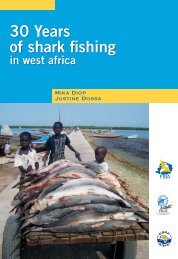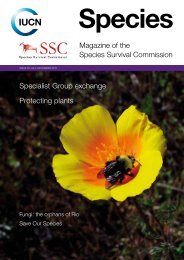Kyne & Simpfendorfer.. - Shark Specialist Group
Kyne & Simpfendorfer.. - Shark Specialist Group
Kyne & Simpfendorfer.. - Shark Specialist Group
Create successful ePaper yourself
Turn your PDF publications into a flip-book with our unique Google optimized e-Paper software.
SECTION I.<br />
BIODIVERSITY AND AN ANNOTATED CHECKLIST OF<br />
DEEPWATER CHONDRICHTHYANS<br />
DEEPWATER BIODIVERSITY<br />
The total number of known chondrichthyan species currently stands at 1193; comprising 498<br />
sharks, 646 batoids and 49 holocephalans (numbers calculated from a global checklist<br />
updated and modified from Compagno (2005)). These figures include both described and<br />
undescribed species. The latter group are those new or recently identified species yet to be<br />
formally treated by science and as such do not yet possess a binomial scientific name.<br />
Of the global fauna, some 581 chondrichthyans are considered to be deepwater species<br />
(applying the definition outlined in the general introduction of this report), representing<br />
48.7% of the global total. The deepwater fauna is divided between 278 sharks (55.8% of<br />
global), 257 batoids (39.8% of global) and 46 holocephalans (93.9% of global). All nine<br />
orders of elasmobranch and the single holocephalan order are represented in the deepsea, and<br />
Table 1.1 provides a summary of deepwater species (both described and undescribed) by<br />
order and family. The bulk of the deepwater shark fauna is attributable to the squaloid<br />
dogfishes and scyliorhinid catsharks, together comprising 84.5% of deepsea sharks. Three<br />
families of skates (Arhynchobatidae, Rajidae and Anacanthobatidae) dominate the deepwater<br />
batoid fauna, together comprising 89.9% of deepsea batoids.<br />
A full annotated checklist of deepwater chondrichthyans appears at the end of this Section.<br />
The total number of known species is ever increasing as exploratory and taxonomic work<br />
ensues. Undescribed taxa represent over one fifth (21%) of all known deepwater<br />
chondrichthyans. This high percentage illustrates two important points. Firstly, the overall<br />
lack of knowledge of the deepsea fauna at even the most basic (i.e. taxonomic) level.<br />
Secondly, that the deepsea chondrichthyan fauna is far from fully documented. For example,<br />
a recent joint Australian/Indonesian project monitoring the landings of chondrichthyans at<br />
various fish markets in Indonesia has revealed several previously unknown deepsea taxa<br />
amongst a larger number of new species (White et al. 2006). The majority of fishing in<br />
Indonesia is still focused on coastal and pelagic resources, with relatively little deepsea<br />
fishing activity. With continuing exploitation of traditional resources, fishing activities will<br />
likely move to deeper water around Indonesia, and the discovery of new fauna will likely<br />
continue. The checklist of known species will also continue to grow as material is gathered<br />
and examined from exploratory research cruises to previously poorly surveyed ocean regions.<br />
The 2003 NORFANZ cruise, surveying the seamounts and abyssal plains around the Lord<br />
Howe and Norfolk Ridges in the Western Pacific is one such example (Last 2007). Priede et<br />
al. (2006) note, however, that the discovery of new species of chondrichthyans at<br />
considerable depth (>3000m) is unlikely given present bathymetrical distributions and the<br />
apparent inability of chondrichthyans to exploit the deepest habitat zones.<br />
The systematics and inter-relationships of several groups of deepsea chondrichthyans remains<br />
unresolved and as these groups are reviewed by taxonomists, the total number of species will<br />
ultimately change. One of the more taxonomically complex groups is the gulper sharks of the<br />
genus Centrophorus. The gulper shark fauna of the Indo-West Pacific is currently under<br />
review and many species traditionally considered to be wide-ranging with global distributions<br />
11
















